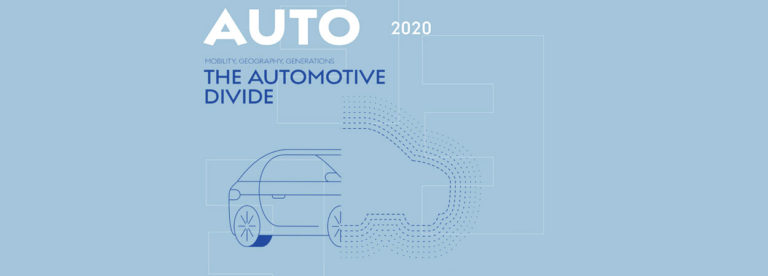Young people and urbanites take the lead


CARS ARE TODAY ESSENTIAL IN RURAL AREAS
Throughout this survey, we have identified non-geographical divides both between millennials and seniors, and between the inhabitants of large cities and rural dwellers. The three indicators used highlight these schisms.
The Car Use Now indicator is highest in the least densely populated regions, confirming the importance of cars for those living in rural areas far from urban centres, where alternatives to cars are the rarest. The results shift gradually as we head towards cities with more than 1 million habitants, which post the lowest scores. Indeed, these urban areas provide more competition for cars in both economic and practical terms, thanks to public transport and so-called “active” modes of transport (walking, cycling, etc.). Urbanites not only consider cars less essential, but even inappropriate in many cases.
If we compare the generations, ignoring divergences between types of residential area, the scores do not highlight any significant differences when it comes to traditional car use.
THE FUTURE OF NEW MOBILITY SOLUTIONS IN URBAN AREAS WILL BE FUELED BY THE YOUNGER GENERATIONS
It makes perfect sense that the Car Use New and Car Use
Next indicators, which reflect the emergence of new mobility
solutions, should post the highest scores in large cities. And
yet, these figures fail to reach the levels attained by Car Use
Now. However, setting generational differences aside, the
difference between the smallest and largest cities is often
two fold.
And on the topic of age, seniors post significantly lower scores for Car Use New and Car Use Next. Given that they are more comfortable with digital booking platforms and often face greater financial constraints, millennials are quicker to adopt new ways of using and paying for car-related services, and even more declare that they are doing so.
It is interesting to correlate these results with those obtained regarding people’s technophilia and their adoption of innovations. The percentage of people under 55 who are willing to immediately try a new product, service or concept store is twice as high as the proportion of over-55s. The same is true of peer-to-peer services.
Traditional car ownership and use
| Age 18-34 | Age 35-54 | Age 55 and over | |
|---|---|---|---|
| In a city with more than 1,000,000 inhabitants | 4 | 4,4 | 3,6 |
| In a city with between 100,001 and 1,000,000 inhabitants | 4,3 | 4,5 | 4,2 |
| In a city with between 20,000 and 100,000 inhabitants | 4,5 | 4,8 | 4,7 |
| In a rural area / in a city with fewer than 20,000 inhabitants | 5,1 | 5,5 | 5,4 |
Stated adoption of new automobility solutions and ways of accessing cars
| Age 18-34 | Age 35-54 | Age 55 and over | |
|---|---|---|---|
| In a city with more than 1,000,000 inhabitants | 3,5 | 2,8 | 2,1 |
| In a city with between 100,001 and 1,000,000 inhabitants | 3,1 | 2,4 | 1,9 |
| In a city with between 20,000 and 100,000 inhabitants | 3,1 | 2,2 | 1,8 |
| In a rural area / in a city with fewer than 20,000 inhabitants | 2,5 | 1,8 | 1,7 |
Stated intention to adopt new automobility solutions and ways of accessing cars
| Age 18-34 | Age 35-54 | Age 55 and over | |
|---|---|---|---|
| In a city with more than 1,000,000 inhabitants | 3,5 | 2,8 | 2,1 |
| In a city with between 100,001 and 1,000,000 inhabitants | 3,1 | 2,4 | 1,9 |
| In a city with between 20,000 and 100,000 inhabitants | 3,1 | 2,2 | 1,8 |
| In a rural area / in a city with fewer than 20,000 inhabitants | 2,5 | 1,8 | 1,7 |
In %
| Age under 55 | Age 55 and over | |
|---|---|---|
| City with fewer than 1,000,000 inhabitants | 51 % | 33 % |
| City with more than 1,000,000 inhabitants | 59 % | 34 % |
| Age under 55 | Age 55 and over | |
|---|---|---|
| City with fewer than 1,000,000 inhabitants | 54 % | 36 % |
| City with more than 1,000,000 inhabitants | 58 % | 30 % |
FUTURE AUTOMOBILITY: A CHASM BETWEEN CITIES AND RURAL AREAS THAT WILL BE HARD TO BRIDGE
It is reasonable to project that a generational effect will lead to current and future innovations spreading far and wide, with future seniors retaining the habits of their youth as they age, not least the latest ways in which cars can be used.
However, the indicators relating to future uses (Car Use Next) in rural and sparsely populated areas do not reach the levels observed in cities. This clearly points to the limited degree to which new forms of automobility can develop outside megacities.
